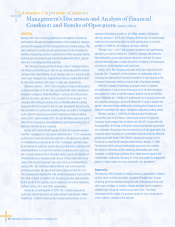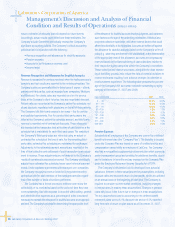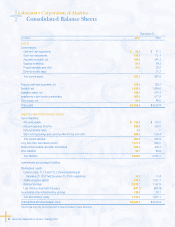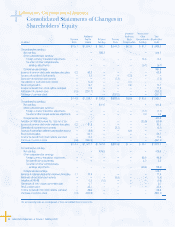LabCorp 2007 Annual Report Download - page 28
Download and view the complete annual report
Please find page 28 of the 2007 LabCorp annual report below. You can navigate through the pages in the report by either clicking on the pages listed below, or by using the keyword search tool below to find specific information within the annual report.
Management’s Discussion and Analysis of Financial
Condition and Results of Operations (Dollars in millions)
26 Laboratory Corporation of America® Holdings 2007
nature, estimates of amounts that will depend on future events.
Accordingly, actual results could differ from these estimates. The
Company’s Audit Committee periodically reviews the Company’s
signifi cant accounting policies. The Company’s critical accounting
policies arise in conjunction with the following:
• Revenue recognition and allowances for doubtful accounts;
• Pension expense;
• Accruals for self insurance reserves; and
• Income taxes
Revenue Recognition and Allowance for Doubtful Accounts
Revenue is recognized for services rendered when the testing process is
complete and test results are reported to the ordering physician. The
Company’s sales are generally billed to three types of payers – clients,
patients and third parties, such as managed care companies, Medicare
and Medicaid. For clients, sales are recorded on a fee-for-service
basis at the Company’s client list price, less any negotiated discount.
Patient sales are recorded at the Company’s patient fee schedule, net
of any discounts negotiated with physicians on behalf of their patients.
The Company bills third-party payers in two ways – fee-for-service
and capitated agreements. Fee-for-service third-party payers are
billed at the Company’s patient fee schedule amount, and third-party
revenue is recorded net of contractual discounts. These discounts
are recorded at the transaction level at the time of sale based on a fee
schedule that is maintained for each third-party payer. The majority of
the Company’s third-party sales are recorded using an actual or
contracted fee schedule at the time of sale. For the remaining third-
party sales, estimated fee schedules are maintained for each payer.
Adjustments to the estimated payment amounts are recorded at the
time of fi nal collection and settlement of each transaction as an adjust-
ment to revenue. These adjustments are not material to the Company’s
results of operations in any period presented. The Company periodically
adjusts these estimated fee schedules based upon historical payment
trends. Under capitated agreements with managed care companies,
the Company recognizes revenue based on a negotiated monthly
contractual rate for each member of the managed care plan regard-
less of the number or costs of services performed.
The Company has a formal process to estimate and review the
collectibility of its receivables based on the period of time they have
been outstanding. Bad debt expense is recorded within selling, general
and administrative expenses as a percentage of sales considered
necessary to maintain the allowance for doubtful accounts at an appropri-
ate level. The Company’s process for determining the appropriate level
of the allowance for doubtful accounts involves judgment, and considers
such factors as the age of the underlying receivables, historical and
projected collection experience, and other external factors that could
affect the collectibility of its receivables. Accounts are written off against
the allowance for doubtful accounts based on the Company’s write-off
policy (e.g., when they are deemed to be uncollectible). In the determination
of the appropriate level of the allowance, accounts are progressively
reserved based on the historical timing of cash collections relative to
their respective aging categories within the Company’s receivables.
These collection and reserve processes, along with the close monitor-
ing of the billing process, help reduce the risks of material revisions to
reserve estimates resulting from adverse changes in collection or
reimbursement experience. The following table presents the percent-
age of the Company’s net accounts receivable outstanding by aging
category at December 31, 2007 and 2006:
Days Outstanding 2007 2006
0 – 30 42.4% 44.9%
31 – 61 22.2% 19.3%
61 – 91 10.5% 11.2%
91 – 120 7.6% 7.3%
121 – 150 5.4% 5.2%
151 – 180 3.6% 3.6%
181 – 270 6.8% 6.6%
271 – 360 1.2% 1.6%
Over 360 0.3% 0.3%
Pension Expense
Substantially all employees of the Company are covered by a defi ned
benefi t retirement plan (the “Company Plan”). The benefi ts to be paid
under the Company Plan are based on years of credited service and
compensation earned while an employee of LabCorp. The Company
also has a nonqualifi ed supplemental retirement plan which covers its
senior management group and provides for additional benefi ts, due in
part to limitations on benefi ts and pay imposed on the Company Plan
under the Employee Retirement Income Security Act of 1974.
The Company’s net pension cost is developed from actuarial
valuations. Inherent in these valuations are key assumptions, including
discount rates and expected return on plan assets, which are updated
on an annual basis at the beginning of each year. The Company is
required to consider current market conditions, including changes
in interest rates, in making these assumptions. Changes in pension
costs may occur in the future due to changes in these assumptions.
The key assumptions used in accounting for the defi ned benefi t
retirement plans were a 6.1% discount rate and an 8.5% expected
long-term rate of return on plan assets as of December 31, 2007.
Laboratory Corporation of America
























